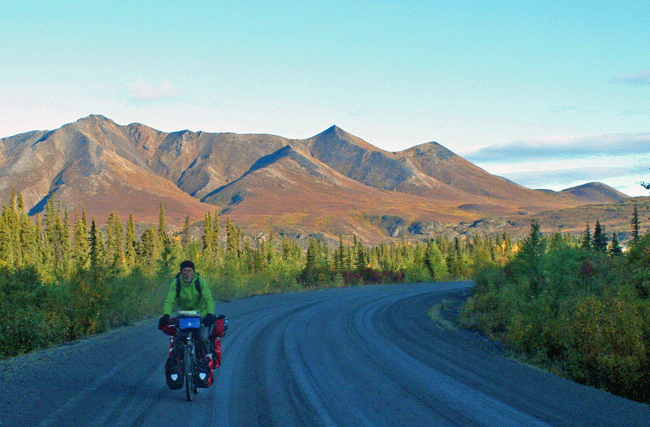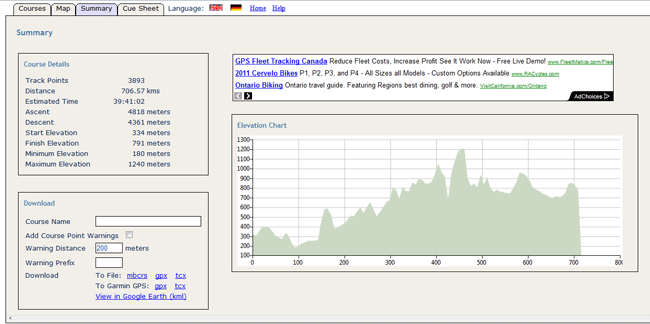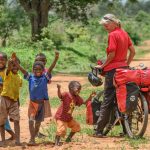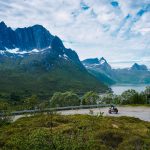1. Be Bear Smart.
If you’re cycling through Western Canada and up to the Yukon, your chance of coming in contact with bears is about 99.99%.
Cyclists rarely encounter problems with bears, but you will want to prepare yourself before entering bear territory.
A good place to start is on the Candaian National Parks bear awareness page.
Here are a few of our recommendations:
Carry bear spray. And don’t stuff it into the bottom of your back pannier. Ideally, attach it to your handlebars or strap it on to your body.
NEVER store your food or toiletries in the tent. Hanging your food in a tree is much easier said than done. We found the best place for overnight food storage is in the bear-proof garbage containers.
That’s right in the garbage can. Just open up the back of the container and slip you food supplies in next to the plastic bag.
2. Stock up at Discount Supermarkets
Food-wise, Canada is the most expensive country we’ve ever cycled through. The further north you bike, the higher the prices.
You can save a lot of money by doing your shopping at the Canadian Superstore, Walmart or Extra Foods in larger towns. You may have to carry up to a week’s worth of supplies, but the difference in your bank account balance will be worth the extra weight.
At the Superstore and Extra Foods look for the hot-pink 50% stickers. These products have passed their ‘best-before’ date. Remember, that doesn’t mean ‘no good after’.
3. Camp at Rest Areas
Official campsites are pricey… $12 to pitch a tent in Yukon National Parks and around $16 in British Columbia’s National Parks. RV parks charge around $25-$30 and showers are often extra.
Up north, Rest Areas are an economical alternative. You’ll usually have a picnic table, grassy area for the tent and bear-proof garbage receptacles in which to store your food. Unless you’re close to a town (and less face it, there aren’t many of those in the Yukon) there’s no need to worry about a peaceful night’s sleep being interrupted by a visit from the RCMP (the cops) or a truckload of bothersome drunks.
4. Protect yourself from the Mossies
Mosquitoes are often referred to as Canada’s national bird. A swarm of them buzzing about your head on a long slog up a steep hill is enough for even the most zen-like cyclist to burst into a barrage of curses.
A head net is a good solution. Even better is a lightweight mossie-proof jacket. And don’t forget the mosquito coils…they’ll make camping a whole lot more fun.
5. Try a few Backroads.
Veering off on to the path less pedaled will reap huge rewards in Western Canada. A detour up the Dempster Highway-- even if it’s just for a visit to Tombstone Territorial Park,--should not be missed.
Likewise, you’ll want to ride over the Top of the World Highway into Alaska and take in the stunning 360-degree views. The Cassiar Highway will give you a true taste of the wilderness, bears to boot.
True adventure can be found on the Robert Campbell Highway. It’s rough, remote and largely unpaved but worth the effort. Or so I’m told by hard-core cyclist Jeff Kruys.
We wimped out in the end and still regret opting for the easy way round.

6. Take a Tarp.
Rain was a constant companion as we biked Canada. Savvy cyclists will take along a lightweight tarp to protect themselves from the elements.
7. Touch Bases at the Tourist Information Centers
These are great places to relax and take advantage of the free coffee and clean restrooms. Tourist Information Centers are also useful for the free maps and as a place to recharge computers and other gadgets.
8. Lighten your Load
In Western Canada, you’ll hardly have a day without at least a couple grueling climbs. It’ll pay off to trade in those 5 novels you’ve been hoarding for a Kindle and leave the yoga mat at home.

9. Check out Warm Showers and Couchsurfing
There are many active members of Warm Showers and Couchsurfing in Western Canada. Why pitch the tent when you can enjoy a soft bed and a roof over your head?
10.Get the Right Gear
Weather in Western Canada and the Yukon is notoriously unpredictable. You’re likely to encounter lots of rain on your ride and maybe even a snowstorm or two if you tour in the shoulder seasons: April and May or September and October.
Good raingear is essential. You’ll also want to pack cold weather clothing including a thick pair of gloves for those chilly Yukon mornings.
11. Check out the Milepost
The Milepost is the ultimate road trip guide through the Yukon and up to Alaska. Useful information about everything there is to see along the way.
12. Allow yourself plenty of time
To get the most out of your ride, you won’t want to rush.
Bad weather can slow you down and some days you may just want to pitch your tent early and wander around in the great outdoors contemplating the incredible beauty which surrounds you. Setting yourself a goal of 100 kilometers per day/ seven days a weeks will probably just stress you out and you’ll miss the best Canada has to offer.





These are good tips; however, please realize that not all of Canada is remote and wild. To give some perspective, 75% of Canadians live within 100 miles of the US border. The farther north from the US border you go, generally the fewer the number of communities. Bear Country warnings are very real and to be taken seriously. When planning your travels in the more remote areas, be careful about stocking up on water/food and carry repair supplies for your bike. Unlike other regions in the world, help can be far away and most locals will admire your bravery/determination for cycling in our northern regions.